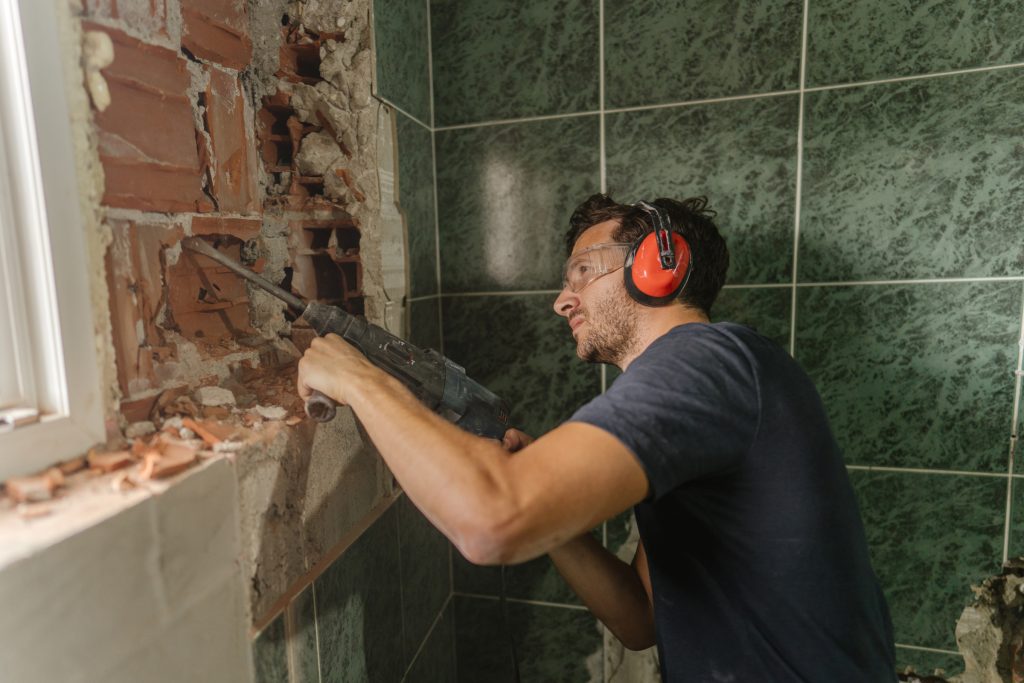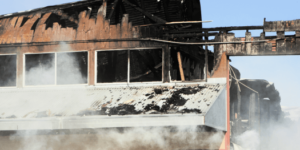You see water where it’s not supposed to be. Find out where it starts, stop it, then find out where it ends.

Finding All of the Water
Moisture detection is tricky. Something that looks and feels dry can actually have enough moisture in it to cause deterioration and mold growth.
Your first option is to call a water damage restoration company. Most companies offer free inspections that include detailed estimates with an explanation of exactly what they plan to do. If a company is asking for a fee, chances are the next one you call won’t.
If you’re a DIY’er through and through, you may want to handle this part yourself too. You’re going to need a moisture meter if so. There are two main types of moisture meters; pin and pinless.
Pin Type Moisture Meters
Pin type moisture meters are excellent for checking the moisture content of wood materials. However, you have to insert the pins into the material, leaving two small holes that will need to be repaired later.
Here’s a quality pin type moisture meter you can purchase at most home improvement stores: Pin Type Moisture Meter
Pinless Type Moisture Meters
Pinless type moisture meters are a bit more versatile and great for checking the moisture content of drywall, concrete, and wood. This type of meter is non-invasive which makes it great for inspecting larger areas.
Here’s a quality pinless type moisture meter you can purchase at most home improvement stores: Pinless Type Moisture Meter
There are also moisture meters that include pin and pinless features.
Neither of these meters work very well for detecting moisture in carpet, carpet pad, and subfloor underneath carpet.
There are specialty meters that are designed to detect the moisture content in these materials, but you can also detach the carpet and feel the carpet pad for moisture and then use the meter underneath the carpet pad to check the subfloor.
Keep in mind, improperly detaching the carpet can damage the carpet backing and make it difficult to reattach. It may also be difficult to reattach the carpet if you need to detach an area bigger than a corner.
How Much Water Is Okay?
Moisture meters measure moisture content from 0.0 to 99.9, with 0.0 being the lowest. Almost everything has some amount of moisture in it and that’s alright. The specific amount that’s a cause for concern varies depending on the material.
These are common materials and the maximum amount of moisture they should have:
Carpet – 12
Drywall – 15
MDF – 15
Engineered Hardwood Floors – 15
Hardwood Floors – 20
Wood – 20
Concrete – 20
Tile – 20*
*Moisture meters have low accuracy when used on ceramic materials.
How Long Has It Been There?
There are a few different things that may help you get an idea of how long water damage has been present.
Deterioration of any material is a more obvious sign of long-term water damage. Discoloration rings around drywall, wood, or concrete may indicate that water has affected these materials, somewhat dried, then become wet again.
If you can see mold, the water damage has been there for at least 48-72 hours. If the mold is only white or green, it’s most likely been there for 3-7 days.
If the mold is any other color and somewhat extensive, it’s probably been there for more than a week and will likely be accompanied by deterioration and discoloration.
Engineered wood floors usually start buckling after 48-72 hours. Hardwood floors can take anywhere from 3-16 days to start buckling; thicker wood usually takes longer to buckle.
Removing the Water
A dry/wet shop vac can go a long way in a lot of water damage situations. Most shop vacs can handle at least a few rooms worth of water, but you’ll need to empty the water a few times.
For larger or more heavily affected areas, you may need a larger extraction unit. These units are available to rent at large home improvement stores.
What Can Be Damp
Certain materials may still feel damp after the water has been extracted and it’s nothing to be worried about. Carpet, rugs, textiles, and unpolished concrete will still feel damp to the touch after extraction.
Other materials, like hardwood floors, tile, and polished concrete should feel completely dry.
Dry What You Can, Remove What You Can't
Once the water is extracted, the area will need to be dried. Materials that can usually be dried are wood, drywall, carpet, and concrete. Materials that can’t usually be dried are MDF, fiberboard, engineered hardwood, plaster, carpet pad, and insulation.
You’ll need fans and dehumidifiers the dry out the area. The purpose of the fans is to circulate the dry and moist air to speed up the evaporation of the moisture in the materials.
Dehumidifiers are the machines that will be doing the heavy lifting by actually removing the moisture from the air, causing more moisture to be pulled into the air.
The exact amount of dehumidification needed for an area depends on several factors. You can use a dehumidification calculator online, or call a restoration company for the most accurate calculation.
Most restoration companies will offer free advice over the phone and answer any questions you have. Don’t hesitate to call around and get as informed as possible.







